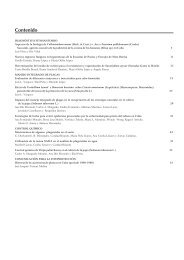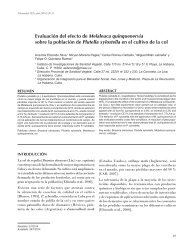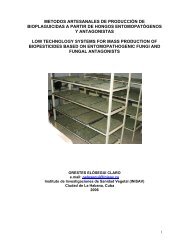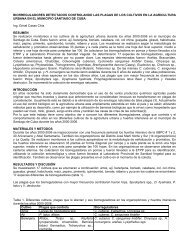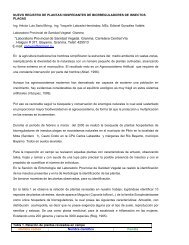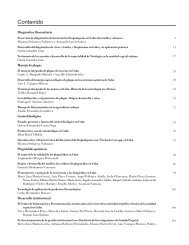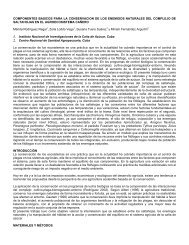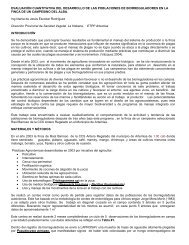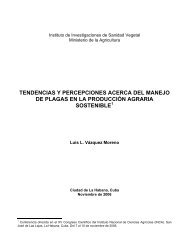3 - Instituto de Investigaciones de Sanidad Vegetal
3 - Instituto de Investigaciones de Sanidad Vegetal
3 - Instituto de Investigaciones de Sanidad Vegetal
You also want an ePaper? Increase the reach of your titles
YUMPU automatically turns print PDFs into web optimized ePapers that Google loves.
FITOSANIDAD 15 (3) septiembre (2011) 147-151<br />
Control biológico<br />
PATOGENICIDAD DE LOS HONGOS METARHIZIUM<br />
ANISOPLIAE (METSCHN.), LECANICILLIUM LECANII (ZIMM.)<br />
ZARE & GAMS Y BEAUVERIA BASSIANA (BALS.-CRIV.) VUILL.<br />
SOBRE THRIPS PALMI KARNY EN EL CULTIVO DE LA PAPA<br />
(SOLANUM TUBEROSUM L.)<br />
Ana Ibis Elizondo Silva, Carlos A. Murguido Morales y Michel Matamoros Torres<br />
<strong>Instituto</strong> <strong>de</strong> <strong>Investigaciones</strong> <strong>de</strong> <strong>Sanidad</strong> <strong>Vegetal</strong>. Calle 110 no. 514 e/ 5. a B y 5. a F, Playa, La Habana,<br />
C.P. 11600, aelizondo@inisav.cu<br />
RESUMEN<br />
Thrips palmi Karny ataca varios cultivos entre los que se encuentra la<br />
papa (Solanum tuberosum L.), y para su control se han investigado<br />
diversas alternativas <strong>de</strong> manejo integrado <strong>de</strong> plagas. El control biológico<br />
mediante el uso <strong>de</strong> bioplaguicidas es parte fundamental <strong>de</strong> ello,<br />
pero aún falta abundar en cuanto a su utilización en condiciones <strong>de</strong><br />
campo. Con el propósito <strong>de</strong> profundizar en este conocimiento se<br />
<strong>de</strong>sarrolló un experimento en el que se estudió el efecto <strong>de</strong> los<br />
bioplaguicidas artesanales <strong>de</strong> los hongos entomopatógenos<br />
Metarhizium anisopliae (Metschn.), Lecanicillium lecanii (Zimm.) Zare<br />
& Gams y Beauveria bassiana (Bals.-Criv.) Vuill. sobre la población<br />
<strong>de</strong> la plaga, así como la patogenicidad y su influencia en el rendimiento.<br />
La aplicación <strong>de</strong> los bioplaguicidas disminuyó la población<br />
<strong>de</strong> T. palmi significativamente respecto al testigo sin tratamiento; el<br />
mayor porcentaje <strong>de</strong> mortalidad lo alcanzaron M. anisopliae a la dosis<br />
<strong>de</strong> 1,7 x 10 13 conidios/ha y L. lecanii 1,5 x 10 13 conidios/ha. No se<br />
encontraron diferencias significativas en el número y peso <strong>de</strong> los<br />
tubérculos entre las variantes tratadas, pero sí respecto al testigo.<br />
Palabras claves: Thrips palmi, Metarhizium anisopliae, Lecanicillium<br />
lecanii, Beauveria bassiana, papa<br />
ABSTRACT<br />
Thrips palmi Karny attacks several crops where potato (Solanum<br />
tuberosum L.) is one of them so diverse alternatives of Integrated Pest<br />
Management have been proved for its control. Biological control by<br />
use of biopestici<strong>de</strong>s is a fundamental part of it, but it is still limited<br />
because the necessity of knowing more about their behaviour un<strong>de</strong>r<br />
field conditions. With the purpose of enlarging this knowledge an<br />
experiment to study the effect of handma<strong>de</strong> biopestici<strong>de</strong>s prepared<br />
from entomopathogenics fungi Metarhizium anisopliae (Metschn.),<br />
Lecanicillium lecanii (Zimm.) Zare & Gams and Beauveria bassiana<br />
(Bals.-Criv.) Vuill. was <strong>de</strong>veloped on potato crop, where the reduction<br />
of the pest population as well as pathogenesis and its influence on<br />
yields were measured. Biopestici<strong>de</strong>s application reduced significantly<br />
T. palmi population regarding the control without treatment; biggest<br />
mortality percentage were reached by M. anisopliae (1.7 x 10 13 conidia/ha<br />
and L. lecanii (1.5 x 10 13 conidia/ha). Number and weight of tubers did<br />
not show significant differences in treated variants, but it was positive<br />
respect to control.<br />
Key words: Thrips palmi, Metarhizium anisopliae, Lecanicillium<br />
lecanii, Beauveria bassiana, potato<br />
INTRODUCCIÓN<br />
El uso <strong>de</strong> insecticidas químicos para el control <strong>de</strong><br />
T. palmi ha sido una práctica ampliamente utilizada a<br />
nivel mundial; sin embargo, el elevado precio que tienen<br />
en el mercado, la ten<strong>de</strong>ncia internacional a disminuir<br />
la carga tóxica en la agricultura, la contaminación<br />
ambiental y el escaso número <strong>de</strong> moléculas capaces <strong>de</strong><br />
alcanzar la efectividad esperada han conducido a la búsqueda<br />
<strong>de</strong> nuevas alternativas <strong>de</strong> control [Murguido et<br />
al., 2002].<br />
Parker et al. (2011) realizaron experimentos con<br />
diferentes aislados <strong>de</strong> los hongos entomopatógenos<br />
M. anisopliae y B. bassiana colectados en campo al<br />
infestar este trips. Por su parte, Proprawski y Wraight<br />
(2000) refieren que se han <strong>de</strong>scubierto numerosos orga-<br />
Recibido: 13/5/2011<br />
Aceptado: 31/8/2011<br />
147



